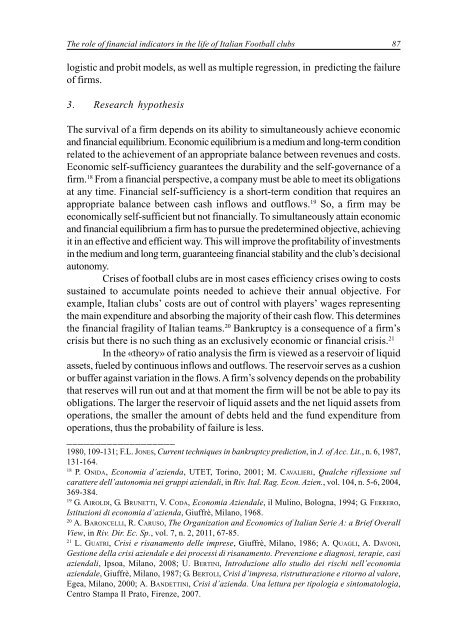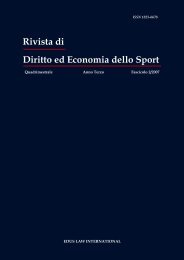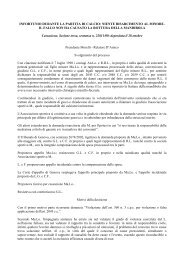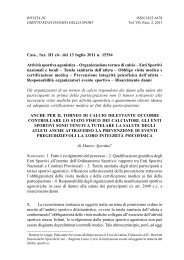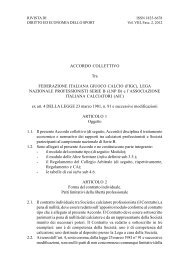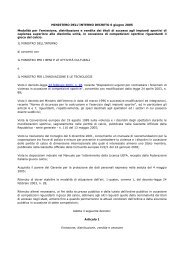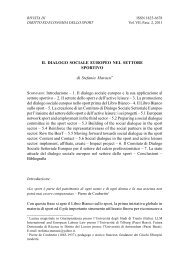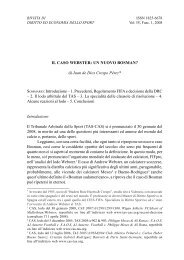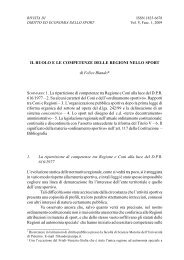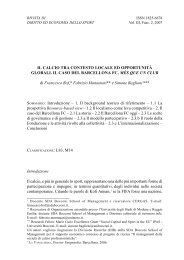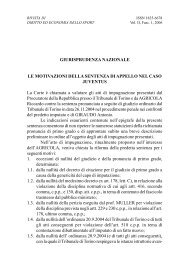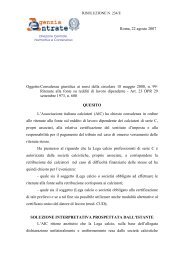Scarica il fascicolo completo - Rdes.It
Scarica il fascicolo completo - Rdes.It
Scarica il fascicolo completo - Rdes.It
Create successful ePaper yourself
Turn your PDF publications into a flip-book with our unique Google optimized e-Paper software.
The role of financial indicators in the life of <strong>It</strong>alian Football clubs 87<br />
logistic and probit models, as well as multiple regression, in predicting the fa<strong>il</strong>ure<br />
of firms.<br />
3. Research hypothesis<br />
The survival of a firm depends on its ab<strong>il</strong>ity to simultaneously achieve economic<br />
and financial equ<strong>il</strong>ibrium. Economic equ<strong>il</strong>ibrium is a medium and long-term condition<br />
related to the achievement of an appropriate balance between revenues and costs.<br />
Economic self-sufficiency guarantees the durab<strong>il</strong>ity and the self-governance of a<br />
firm. 18 From a financial perspective, a company must be able to meet its obligations<br />
at any time. Financial self-sufficiency is a short-term condition that requires an<br />
appropriate balance between cash inflows and outflows. 19 So, a firm may be<br />
economically self-sufficient but not financially. To simultaneously attain economic<br />
and financial equ<strong>il</strong>ibrium a firm has to pursue the predetermined objective, achieving<br />
it in an effective and efficient way. This w<strong>il</strong>l improve the profitab<strong>il</strong>ity of investments<br />
in the medium and long term, guaranteeing financial stab<strong>il</strong>ity and the club’s decisional<br />
autonomy.<br />
Crises of football clubs are in most cases efficiency crises owing to costs<br />
sustained to accumulate points needed to achieve their annual objective. For<br />
example, <strong>It</strong>alian clubs’ costs are out of control with players’ wages representing<br />
the main expenditure and absorbing the majority of their cash flow. This determines<br />
the financial frag<strong>il</strong>ity of <strong>It</strong>alian teams. 20 Bankruptcy is a consequence of a firm’s<br />
crisis but there is no such thing as an exclusively economic or financial crisis. 21<br />
In the «theory» of ratio analysis the firm is viewed as a reservoir of liquid<br />
assets, fueled by continuous inflows and outflows. The reservoir serves as a cushion<br />
or buffer against variation in the flows. A firm’s solvency depends on the probab<strong>il</strong>ity<br />
that reserves w<strong>il</strong>l run out and at that moment the firm w<strong>il</strong>l be not be able to pay its<br />
obligations. The larger the reservoir of liquid assets and the net liquid assets from<br />
operations, the smaller the amount of debts held and the fund expenditure from<br />
operations, thus the probab<strong>il</strong>ity of fa<strong>il</strong>ure is less.<br />
___________________<br />
1980, 109-131; F.L. JONES, Current techniques in bankruptcy prediction, in J. of Acc. Lit., n. 6, 1987,<br />
131-164.<br />
18 P. ONIDA, Economia d’azienda, UTET, Torino, 2001; M. CAVALIERI, Qualche riflessione sul<br />
carattere dell’autonomia nei gruppi aziendali, in Riv. <strong>It</strong>al. Rag. Econ. Azien., vol. 104, n. 5-6, 2004,<br />
369-384.<br />
19 G. AIROLDI, G. BRUNETTI, V. CODA, Economia Aziendale, <strong>il</strong> Mulino, Bologna, 1994; G. FERRERO,<br />
Istituzioni di economia d’azienda, Giuffrè, M<strong>il</strong>ano, 1968.<br />
20 A. BARONCELLI, R. CARUSO, The Organization and Economics of <strong>It</strong>alian Serie A: a Brief Overall<br />
View, in Riv. Dir. Ec. Sp., vol. 7, n. 2, 2011, 67-85.<br />
21 L. GUATRI, Crisi e risanamento delle imprese, Giuffrè, M<strong>il</strong>ano, 1986; A. QUAGLI, A. DAVONI,<br />
Gestione della crisi aziendale e dei processi di risanamento. Prevenzione e diagnosi, terapie, casi<br />
aziendali, Ipsoa, M<strong>il</strong>ano, 2008; U. BERTINI, Introduzione allo studio dei rischi nell’economia<br />
aziendale, Giuffrè, M<strong>il</strong>ano, 1987; G. BERTOLI, Crisi d’impresa, ristrutturazione e ritorno al valore,<br />
Egea, M<strong>il</strong>ano, 2000; A. BANDETTINI, Crisi d’azienda. Una lettura per tipologia e sintomatologia,<br />
Centro Stampa Il Prato, Firenze, 2007.


